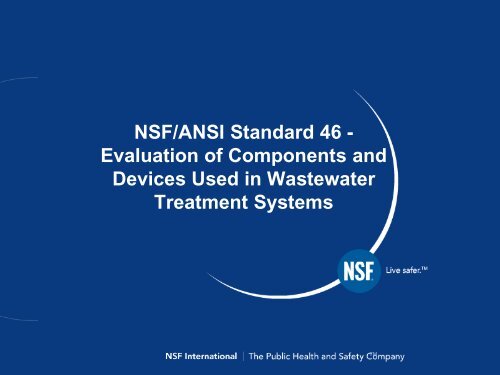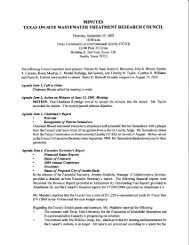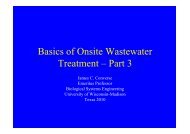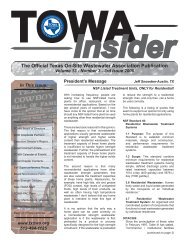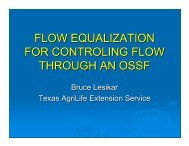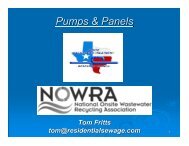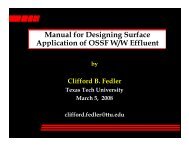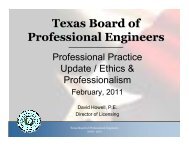NSF/ANSI Standard 46 - Evaluation of Components and Devices ...
NSF/ANSI Standard 46 - Evaluation of Components and Devices ...
NSF/ANSI Standard 46 - Evaluation of Components and Devices ...
You also want an ePaper? Increase the reach of your titles
YUMPU automatically turns print PDFs into web optimized ePapers that Google loves.
<strong>NSF</strong>/<strong>ANSI</strong> <strong>St<strong>and</strong>ard</strong> <strong>46</strong> -<br />
<strong>Evaluation</strong> <strong>of</strong> <strong>Components</strong> <strong>and</strong><br />
<strong>Devices</strong> Used in Wastewater<br />
Treatment Systems
Today’s Agenda<br />
• Brief overview <strong>of</strong> current <strong>NSF</strong>/<strong>ANSI</strong> Onsite<br />
Wastewater Treatment Product <strong>St<strong>and</strong>ard</strong>s<br />
• Review <strong>of</strong> <strong>St<strong>and</strong>ard</strong> <strong>46</strong>, include a running account<br />
<strong>of</strong> changes proposed in Draft <strong>NSF</strong> <strong>St<strong>and</strong>ard</strong> 385 –<br />
a new st<strong>and</strong>ard under development which will<br />
encompass only disinfection devices<br />
• Questions
<strong>NSF</strong>/<strong>ANSI</strong> Onsite Wastewater<br />
<strong>St<strong>and</strong>ard</strong>s<br />
Brief Overview
<strong>NSF</strong>/American National <strong>St<strong>and</strong>ard</strong>s for Onsite<br />
Wastewater Treatment Systems<br />
• <strong>NSF</strong>/<strong>ANSI</strong> 41-2011 Non-liquid saturated treatment systems (1978)<br />
• <strong>NSF</strong>/<strong>ANSI</strong> <strong>46</strong>-2010 <strong>Evaluation</strong> <strong>of</strong> components <strong>and</strong> devices used in<br />
wastewater (1997)<br />
• <strong>NSF</strong>/<strong>ANSI</strong> 240-2011 Drainfield trench product sizing for gravity<br />
dispersal onsite wastewater treatment <strong>and</strong> dispersal systems (2011)<br />
• <strong>NSF</strong>/<strong>ANSI</strong> 40-2010 Residential wastewater treatment systems (1970)<br />
• <strong>NSF</strong>/<strong>ANSI</strong> 245-2010 Wastewater treatment systems – nitrogen<br />
reduction (2007)<br />
• <strong>NSF</strong>/<strong>ANSI</strong> 350-2011 Onsite residential <strong>and</strong> commercial water reuse<br />
treatment systems (2011)<br />
• <strong>NSF</strong>/<strong>ANSI</strong> 350-1-2011 Onsite residential <strong>and</strong> commercial graywater<br />
treatment systems for subsurface discharge (2011)<br />
• <strong>NSF</strong>/<strong>ANSI</strong> 360-2010 Wastewater treatment systems – field<br />
performance verification (2010)<br />
• More under development
<strong>NSF</strong>/<strong>ANSI</strong> <strong>St<strong>and</strong>ard</strong> <strong>46</strong><br />
• <strong>St<strong>and</strong>ard</strong> <strong>46</strong>: <strong>Evaluation</strong> <strong>of</strong> <strong>Components</strong> <strong>and</strong><br />
<strong>Devices</strong> Used in Wastewater Treatment<br />
Systems - includes<br />
– Grinder pumps<br />
– Septic tank effluent filters<br />
– Disinfection devices<br />
• Chlorine<br />
• Ultraviolet<br />
• Ozone
• <strong>St<strong>and</strong>ard</strong> <strong>46</strong>:<br />
<strong>NSF</strong>/<strong>ANSI</strong> <strong>St<strong>and</strong>ard</strong> <strong>46</strong><br />
– Initially included septic tank effluent filters <strong>and</strong><br />
grinder pumps (1997). Disinfection devices were<br />
added to Std. <strong>46</strong> as they came into more wide<br />
spread use in the industry <strong>and</strong> as the need to<br />
st<strong>and</strong>ardize these components became apparent<br />
– With publication <strong>of</strong> Std. 385 Std. <strong>46</strong> will be revised<br />
to omit disinfection devices
<strong>NSF</strong>/<strong>ANSI</strong> <strong>St<strong>and</strong>ard</strong> <strong>46</strong><br />
• Grinder pumps <strong>and</strong> related components<br />
– The st<strong>and</strong>ard includes requirements for grinder<br />
pumps, pump basins, check <strong>and</strong> air or vacuum<br />
release valves included in the grinder pump<br />
package <strong>and</strong> filtration devices for septic tank<br />
systems<br />
– Intended for pumping wastewater from residential<br />
sources
<strong>NSF</strong>/<strong>ANSI</strong> <strong>St<strong>and</strong>ard</strong> <strong>46</strong><br />
• Chlorination <strong>Devices</strong> Std. <strong>46</strong> Section 11<br />
– Establishes requirements for two classifications <strong>of</strong><br />
chlorination devices rated at 200 - 1,500 GPD:<br />
• Chlorine dispensers – defined as devices that<br />
deliver chlorine in the absence <strong>of</strong> a contact<br />
chamber (385 defines as devices designed to dispense<br />
controlled amounts <strong>of</strong> chlorine into water to achieve an<br />
aqueous solution <strong>of</strong> chlorine)<br />
• Chlorine disinfection devices – devices that<br />
deliver chlorine <strong>and</strong> provide a contact chamber<br />
for demonstrating fecal coliform reduction<br />
Same classifications under Std. 385
<strong>NSF</strong>/<strong>ANSI</strong> <strong>St<strong>and</strong>ard</strong> <strong>46</strong><br />
• Chlorination devices<br />
– Performance testing <strong>and</strong> evaluation<br />
• Consists <strong>of</strong> three procedures:<br />
1. Chlorine resistance test<br />
2. Life test<br />
3. Chlorination test – (Std. 385 omits this test for<br />
dispensers)<br />
• Tests conducted on one or more devices but<br />
the life test <strong>and</strong> chlorination tests must be<br />
conducted on a single device in the order<br />
indicated above
<strong>NSF</strong>/<strong>ANSI</strong> <strong>St<strong>and</strong>ard</strong> <strong>46</strong><br />
• Chlorination devices<br />
– Performance testing <strong>and</strong> evaluation<br />
• Chlorine resistance test – device & parts normally<br />
in contact with chlorine are exposed to “max<br />
concentration” for 100 days (Std. 385 adds a requirement<br />
that the concentration <strong>of</strong> the “soup” be greater than 15<br />
mg/L)<br />
• Performed in the <strong>NSF</strong> lab at Ann Arbor<br />
• Criteria - shall show no visible signs <strong>of</strong> chemical attack or<br />
structural deformation.<br />
(essentially the same test under <strong>46</strong> <strong>and</strong> 385)
<strong>NSF</strong>/<strong>ANSI</strong> <strong>St<strong>and</strong>ard</strong> <strong>46</strong><br />
• Chlorination devices<br />
– Performance testing <strong>and</strong> evaluation<br />
• Life test – 30-day test, no maintenance<br />
– Must contain sufficient chlorine product at test start to<br />
last through testing<br />
– Manufacturer specifies design flow conditions, min.<br />
contact time, min. & max. flow rates, mixing<br />
requirements <strong>and</strong> the chlorine to be used<br />
– Chlorine dispensers - tested at Ann Arbor using<br />
dechlorinated potable water (a default tank provided<br />
as a test contact chamber if not included by Mfg.)<br />
– Chlorination devices - tested so far at Waco site<br />
using actual treated effluent (Mfg. provides contact<br />
chamber)
<strong>NSF</strong>/<strong>ANSI</strong> <strong>St<strong>and</strong>ard</strong> <strong>46</strong><br />
• Chlorination devices<br />
– Performance testing <strong>and</strong> evaluation<br />
• Life test – Hydraulic loading (same for<br />
dispensers <strong>and</strong> devices under existing Std. <strong>46</strong> <strong>and</strong><br />
follows typical Std. 40 dosing pattern)<br />
6 a.m. to 9 a.m. 35% <strong>of</strong> total minimum daily flow<br />
11 a.m. to 2 p.m. 25% <strong>of</strong> total minimum daily flow<br />
5 p.m. to 8 p.m. 40% <strong>of</strong> total minimum daily flow
<strong>NSF</strong>/<strong>ANSI</strong> <strong>St<strong>and</strong>ard</strong> <strong>46</strong><br />
• Chlorination devices<br />
– Performance testing <strong>and</strong> evaluation<br />
• Life test – Hydraulic loading – Under 385,<br />
assumes a more complicated dosing regimen to include<br />
24-hour dosing period, alternating each day between<br />
manufacturer’s max <strong>and</strong> min flow capacity. In addition,<br />
385 requires testing for one day between days 24 <strong>and</strong> 30<br />
over a 12-hour period as follows:<br />
0-3 hours 10% <strong>of</strong> maximum flow<br />
3-6 hours 60% <strong>of</strong> maximum flow<br />
6-9 hours minimum flow rate<br />
9-12 hours 100% <strong>of</strong> maximum flow rate
<strong>NSF</strong>/<strong>ANSI</strong> <strong>St<strong>and</strong>ard</strong> <strong>46</strong><br />
• Chlorination devices<br />
– Performance testing <strong>and</strong> evaluation<br />
• Life test – Influent Wastewater<br />
Characteristics (<strong>46</strong>)<br />
(Characteristics are different for dispensers <strong>and</strong> devices)<br />
– Chlorine dispensers<br />
» From a potable water supply, dechlorinated<br />
pH 6.0 to 9.0<br />
temperature 60 ± 5º F (16 ± 2.5 º C)<br />
Chlorine<br />
≤ 0.1 mg/L
<strong>NSF</strong>/<strong>ANSI</strong> <strong>St<strong>and</strong>ard</strong> <strong>46</strong><br />
• Chlorination devices<br />
– Performance testing <strong>and</strong> evaluation<br />
• Life test – Influent Wastewater<br />
Characteristics – Under 385<br />
(Also different for dispensers <strong>and</strong> devices)<br />
– Chlorine dispensers – exp<strong>and</strong>ed to:<br />
pH 6.0 to 9.0<br />
temperature 60 ± 5º F (16 ± 2.5 º C)<br />
Total Chlorine<br />
TDS<br />
≤ 0.5 mg/L<br />
200 - 500 mg/L<br />
Hardness < 170 mg/L as CaCO 3<br />
TOC<br />
1 - 3 mg/L
<strong>NSF</strong>/<strong>ANSI</strong> <strong>St<strong>and</strong>ard</strong> <strong>46</strong><br />
• Chlorination devices<br />
– Life test – Influent Wastewater Characteristics<br />
– Chlorination devices (<strong>46</strong>)<br />
» From secondary treated effluent<br />
» Criteria:<br />
CBOD 5<br />
TSS<br />
fecal coliform<br />
≤ 25 mg/L<br />
≤ 30 mg/L<br />
≤ 10 4 to 10 6 organisms/100 mL<br />
pH 6.0 to 9.0<br />
temperature.<br />
Ammonia<br />
6º to 30º C (42 to 86 Fº)<br />
≥ 2.0 mg/L <strong>and</strong> ≤ 4.0 mg/L
<strong>NSF</strong>/<strong>ANSI</strong> <strong>St<strong>and</strong>ard</strong> <strong>46</strong><br />
• Chlorination devices<br />
– Life test – Influent Wastewater Characteristics<br />
– Chlorination devices - Under 385<br />
(Also from secondary treated effluent)<br />
» Criteria (exp<strong>and</strong>ed to include):<br />
CBOD 5<br />
TSS<br />
fecal coliform<br />
≥ 10 <strong>and</strong> ≤ 25 mg/L<br />
≥ 10 <strong>and</strong> ≤ 30 mg/L<br />
10 3 to 10 6 organisms/100 mL<br />
pH 6.0 to 9.0<br />
temperature.<br />
Ammonia (for Cl & O 3 tests)<br />
UV transmittance <strong>of</strong> influent<br />
6º to 30º C (42 to 86 Fº)<br />
≥ 4.0 mg/L <strong>and</strong> ≤ 6.0 mg/L<br />
50 – 75 % per cm
<strong>NSF</strong>/<strong>ANSI</strong> <strong>St<strong>and</strong>ard</strong> <strong>46</strong><br />
• Chlorination devices<br />
– Performance testing <strong>and</strong> evaluation<br />
• Life test – General Criteria (for both<br />
dispensers <strong>and</strong> devices):<br />
• At the conclusion <strong>of</strong> the life test there shall be no<br />
visible signs <strong>of</strong> damage or structural change that<br />
may adversely affect proper operation <strong>of</strong> any<br />
components <strong>of</strong> the chlorination device
<strong>NSF</strong>/<strong>ANSI</strong> <strong>St<strong>and</strong>ard</strong> <strong>46</strong><br />
• Chlorination devices<br />
– Performance testing <strong>and</strong> evaluation<br />
• Life test – General Criteria - Under 385<br />
– For dispensers:<br />
» The average chlorine concentration <strong>of</strong> all<br />
hydraulic loading conditions shall be ≥ 15 mg/L<br />
– For devices:<br />
» At the conclusion <strong>of</strong> the life test there shall be no<br />
visible signs <strong>of</strong> damage or structural change that<br />
may adversely affect proper operation <strong>of</strong> any<br />
components <strong>of</strong> the chlorination device
<strong>NSF</strong>/<strong>ANSI</strong> <strong>St<strong>and</strong>ard</strong> <strong>46</strong><br />
• Chlorination devices<br />
– Performance testing <strong>and</strong> evaluation<br />
• Chlorination test – conducted immediately following<br />
the life test with the same device used in life test (both)<br />
– No maintenance performed<br />
– Chlorination devices with two or more disinfectant<br />
feed settings shall be tested at the minimum <strong>and</strong><br />
maximum settings specified by manufacturer<br />
(Under 385 there is no chlorination test for dispensers)
<strong>NSF</strong>/<strong>ANSI</strong> <strong>St<strong>and</strong>ard</strong> <strong>46</strong><br />
• Chlorination devices<br />
– Performance testing <strong>and</strong> evaluation<br />
• Chlorination test – (for both under <strong>46</strong>)<br />
– Hydraulic loading<br />
» Flow Introduced continuously over a 3-hour<br />
period at approximately 40% <strong>of</strong> the rated min.<br />
<strong>and</strong> max. daily hydraulic capacity for each<br />
feed setting<br />
» Requires hydraulic loading at 3 hours per<br />
combination <strong>of</strong> feed <strong>and</strong> flow rates (four<br />
possible combinations) for a total <strong>of</strong> 12 hours
<strong>NSF</strong>/<strong>ANSI</strong> <strong>St<strong>and</strong>ard</strong> <strong>46</strong><br />
• Chlorination devices<br />
– Performance testing <strong>and</strong> evaluation<br />
• Chlorination test –<br />
– Hydraulic loading<br />
» The four combinations are as follows:<br />
1 maximum feed at 40% <strong>of</strong> maximum flow<br />
2 maximum feed at 40% <strong>of</strong> minimum flow<br />
3 minimum feed at 40% <strong>of</strong> maximum flow<br />
4 minimum feed at 40% <strong>of</strong> minimum flow
<strong>NSF</strong>/<strong>ANSI</strong> <strong>St<strong>and</strong>ard</strong> <strong>46</strong><br />
• Chlorination devices<br />
– Performance testing <strong>and</strong> evaluation<br />
• Chlorination test – (Under 385 – devices only)<br />
– Hydraulic loading<br />
» carried out over three, three-hour dosing<br />
periods, each interspersed with a required<br />
purge <strong>of</strong> the contact chamber equaling 2<br />
chamber volumes<br />
» a distinction is made between variable feed<br />
rate devices <strong>and</strong> fixed feed rate devices to<br />
allow for testing at min/max feed rates
<strong>NSF</strong>/<strong>ANSI</strong> <strong>St<strong>and</strong>ard</strong> <strong>46</strong><br />
• Chlorination devices<br />
– Performance testing <strong>and</strong> evaluation<br />
• Chlorination test –<br />
– Influent water characteristics (<strong>46</strong>)<br />
» Same as cited for Life test<br />
– Under 385<br />
» Same as cited for Life test
<strong>NSF</strong>/<strong>ANSI</strong> <strong>St<strong>and</strong>ard</strong> <strong>46</strong><br />
• Chlorination devices<br />
– Performance testing <strong>and</strong> evaluation<br />
• Chlorination test – Effluent Sampling:<br />
Under <strong>46</strong> - A total <strong>of</strong> 5 grab samples shall be<br />
collected, beginning after a minimum <strong>of</strong> 2 chamber<br />
volumes <strong>of</strong> the influent wastewater has passed<br />
through the device <strong>and</strong> continuing at 10-minute<br />
intervals (including contact chamber volume)<br />
Under 385 – a total <strong>of</strong> 5 grab samples also<br />
collected, but during each dosing period at 10, 50,<br />
90, 130 & 170 minutes into the dosing period (influent<br />
E. coli & enterococci measured every time effluent<br />
sample collected)
<strong>NSF</strong>/<strong>ANSI</strong> <strong>St<strong>and</strong>ard</strong> <strong>46</strong><br />
• Chlorination devices<br />
– Performance testing <strong>and</strong> evaluation<br />
• Chlorination test – Effluent Criteria:<br />
– Chlorine dispensers<br />
» The average effluent chlorine concentration <strong>of</strong> all<br />
hydraulic loading conditions shall be ≥ 15 mg/L<br />
– Chlorine disinfection devices<br />
» An average effluent fecal coliform concentration<br />
<strong>of</strong> all hydraulic loading conditions <strong>of</strong> ≤ 200<br />
organisms /100 mL on the first day that the<br />
influent requirements are met
<strong>NSF</strong>/<strong>ANSI</strong> <strong>St<strong>and</strong>ard</strong> <strong>46</strong><br />
• Chlorination devices<br />
– Performance testing <strong>and</strong> evaluation<br />
• Chlorination test – Effluent Criteria:<br />
Under 385 - No chlorination test required for dispensers<br />
– Chlorine disinfection devices<br />
» Geometric mean <strong>of</strong> all required effluent samples<br />
must meet the following pass/fail criteria:<br />
» fecal coliform ≤ 200 organisms /100 mL<br />
» E. coli ≤ 126 organisms /100 mL<br />
» Enterococci ≤ 35 organisms /100 mL
<strong>NSF</strong>/<strong>ANSI</strong> <strong>St<strong>and</strong>ard</strong> <strong>46</strong><br />
• Chlorination devices<br />
– Other requirements (both <strong>46</strong> & 385)<br />
• Failure sensing <strong>and</strong> signaling equipment to detect <strong>and</strong><br />
alert owner to failures with audible <strong>and</strong> visual signal<br />
• Flow design – a designated flow path indicative <strong>of</strong> entire<br />
treatment process<br />
• Service label – A clearly visible label or plate<br />
permanently located in a visible location on the device<br />
providing instructions for obtaining service, including<br />
name, address <strong>and</strong> phone number <strong>of</strong> manufacturer’s<br />
authorized representative <strong>and</strong> the acceptable type <strong>of</strong><br />
chlorine to be used in the device. For dispensers, label<br />
must specify min. size <strong>of</strong> contact tank to be used
<strong>NSF</strong>/<strong>ANSI</strong> <strong>St<strong>and</strong>ard</strong> <strong>46</strong><br />
• Chlorination devices<br />
– Other requirements (continued)<br />
• Data plate – must specify chlorine “dispenser” or “device”<br />
• <strong>NSF</strong> Mark <strong>of</strong> Certification – not certified if not marked<br />
• Ease <strong>of</strong> cleaning – shall allow for easy access<br />
• Valve <strong>and</strong> component identification<br />
• Product literature<br />
• Installation <strong>and</strong> Owner’s manual
<strong>NSF</strong>/<strong>ANSI</strong> <strong>St<strong>and</strong>ard</strong> <strong>46</strong><br />
• Positive displacement pumps Sec. 11.7<br />
– Addresses performance testing <strong>and</strong> evaluation for<br />
chlorination devices incorporating a positive displacement<br />
pump or which operate under increased hydraulic pressure<br />
– Criteria:<br />
– Positive displacement pump systems<br />
» Shall deliver an output rate that is within ± 10%<br />
<strong>of</strong> the delivery specified by the manufacturer<br />
– Pressure applications<br />
» shall show no evidence <strong>of</strong> rupture, leakage, burst<br />
or permanent deformation when subjected to<br />
11/2 times mfg. max operating pressure
<strong>NSF</strong>/<strong>ANSI</strong> <strong>St<strong>and</strong>ard</strong> <strong>46</strong><br />
• Ultraviolet disinfection devices Std. <strong>46</strong><br />
Section 12<br />
– Establishes requirements for UV devices that<br />
deliver UV light radiation to secondary treated<br />
wastewater from small sources such as individual<br />
homes <strong>and</strong> small commercial sources (400 to<br />
1500 GPD) <strong>and</strong> provides an exposure chamber for<br />
fecal coliform reduction that treats wastewater to<br />
less than 200 fecal coliforms per 100 mL<br />
– 385 cites as “exposure chamber for<br />
microbiological organism reduction”
<strong>NSF</strong>/<strong>ANSI</strong> <strong>St<strong>and</strong>ard</strong> <strong>46</strong><br />
• Ultraviolet disinfection devices<br />
– Performance <strong>and</strong> evaluation<br />
• Testing performed on one UV disinfection device<br />
• Device to be tested is determined to be the most<br />
representative model within the model series<br />
• Must be capable <strong>of</strong> operating for 90 days with no<br />
operation or maintenance performed on the device<br />
• Mfg. to specify all key elements for effective UV<br />
disinfection, including design flow conditions, minimum<br />
contact time, mixing requirements <strong>and</strong> max. & min. GPD<br />
wastewater flow rates the device is designed to h<strong>and</strong>le
<strong>NSF</strong>/<strong>ANSI</strong> <strong>St<strong>and</strong>ard</strong> <strong>46</strong><br />
• Ultraviolet disinfection devices<br />
– Performance <strong>and</strong> evaluation<br />
• UV disinfection test<br />
– Assembled, installed <strong>and</strong> operated in accordance<br />
with the manufacturer’s specification<br />
– Mfg. to specify UV lamp to be used – lamp length,<br />
rated output (watts at 254 nm), irradiance at 1 m <strong>and</strong><br />
rated lamp life, defined as the point at which<br />
irradiance is reduced to 70% <strong>of</strong> initial performance<br />
– UV lamp output shall be measured at the beginning<br />
<strong>and</strong> the end <strong>of</strong> the 90-day test period<br />
– (385 adds a 100-hr lamp burn-in prior to testing &<br />
specifies 100% min/max testing at 6 hrs each)
<strong>NSF</strong>/<strong>ANSI</strong> <strong>St<strong>and</strong>ard</strong> <strong>46</strong><br />
• Ultraviolet disinfection devices<br />
– Performance <strong>and</strong> evaluation<br />
• UV disinfection test<br />
– Hydraulic loading (both <strong>46</strong> & 385)<br />
6 a.m. to 9 a.m. 35% <strong>of</strong> total minimum daily flow<br />
11 a.m. to 2 p.m. 25% <strong>of</strong> total minimum daily flow<br />
5 p.m. to 8 p.m. 40% <strong>of</strong> total minimum daily flow<br />
– Dosing volumes measure daily<br />
– 30-day avg. volume <strong>of</strong> wastewater within 100% ±<br />
10% <strong>of</strong> daily rated hydraulic capacity
<strong>NSF</strong>/<strong>ANSI</strong> <strong>St<strong>and</strong>ard</strong> <strong>46</strong><br />
• Ultraviolet disinfection devices<br />
– Performance <strong>and</strong> evaluation<br />
• UV disinfection test<br />
– Influent water characteristics<br />
» actual secondary treated wastewater meeting the<br />
following criteria:<br />
CBOD 5<br />
TSS<br />
Fecal coliform<br />
25 - 45mg/L<br />
30 - 45mg/L<br />
10 4 to 10 6 MPN/100 mL<br />
pH 6.0 to 9.0<br />
temperature.<br />
18º ± 6º C (60 ± 20 Fº)<br />
UV transmittance <strong>of</strong> radiation<br />
50-75% per cm<br />
– 385 – same exp<strong>and</strong>ed infl. characteristics as in<br />
life test
<strong>NSF</strong>/<strong>ANSI</strong> <strong>St<strong>and</strong>ard</strong> <strong>46</strong><br />
• Ultraviolet disinfection devices<br />
– Performance <strong>and</strong> evaluation<br />
• UV disinfection test<br />
– Influent <strong>and</strong> effluent sampling - <strong>46</strong><br />
» Except for fecal coliform, all samples will be flowproportional,<br />
24-hour composites obtained during<br />
periods <strong>of</strong> system dosing<br />
» Daily fecal values shall be the geometric mean <strong>of</strong><br />
three 1-L grab samples<br />
» Samples shall be collected starting the 15 th day <strong>of</strong> the<br />
test <strong>and</strong> at 15-day intervals during the 90-day test<br />
– 385 – two, 1-L grabs, 30 min. after start <strong>of</strong> each<br />
loading period (17 total each loading period for<br />
test)
<strong>NSF</strong>/<strong>ANSI</strong> <strong>St<strong>and</strong>ard</strong> <strong>46</strong><br />
• Ultraviolet disinfection devices<br />
– Performance <strong>and</strong> evaluation<br />
• UV disinfection test<br />
– Criteria (<strong>46</strong>)<br />
» Individual fecal coliform effluent samples not to<br />
exceed 200 organisms/100 mL<br />
» All components designed to be exposed to wastewater<br />
<strong>and</strong> UV light shall be resistant to UV attack, corrosion<br />
<strong>and</strong> structural deformation<br />
385 - Geometric mean <strong>of</strong> all required effluent samples<br />
collected in final 10 weeks must meet the pass/fail<br />
criteria:<br />
» fecal coliform ≤ 200 organisms /100 mL<br />
» E. coli ≤ 126 organisms /100 mL<br />
» Enterococci ≤ 35 organisms /100 mL
<strong>NSF</strong>/<strong>ANSI</strong> <strong>St<strong>and</strong>ard</strong> <strong>46</strong><br />
• Ultraviolet disinfection devices<br />
– Performance <strong>and</strong> evaluation<br />
• End <strong>of</strong> UV lamp life disinfection test<br />
– Evaluates disinfection capability <strong>of</strong> the device with the UV<br />
lamp output adjusted to 70% <strong>of</strong> initial<br />
– UV lamp output is measured after sampling on day 90 – if<br />
the measurement is 70% or less <strong>of</strong> initial output, no end <strong>of</strong><br />
lamp life test is required<br />
– If the measurement is greater than 70% lamp output is<br />
adjusted to 70%<br />
– Run in a 2-day period following the 90 day disinfection test<br />
under same test conditions, collecting samples 30 minutes<br />
after introduction <strong>of</strong> challenge water on day 2<br />
• 385 – Test omitted
<strong>NSF</strong>/<strong>ANSI</strong> <strong>St<strong>and</strong>ard</strong> <strong>46</strong><br />
• Ultraviolet disinfection devices<br />
– Performance <strong>and</strong> evaluation<br />
• End <strong>of</strong> UV lamp life disinfection test<br />
– Criteria (<strong>46</strong>)<br />
» Fecal coliform effluent samples not to exceed 200<br />
organisms/100 mL<br />
– All components designed to be exposed to wastewater<br />
<strong>and</strong> UV light shall be resistant to UV attack, corrosion<br />
<strong>and</strong> structural deformation
<strong>NSF</strong>/<strong>ANSI</strong> <strong>St<strong>and</strong>ard</strong> <strong>46</strong><br />
• Ultraviolet disinfection devices<br />
– Other requirements<br />
• Failure sensing <strong>and</strong> signaling equipment to detect <strong>and</strong><br />
alert owner to failures with audible <strong>and</strong> visual signal<br />
• Flow design – a designated flow path indicative <strong>of</strong> entire<br />
treatment process<br />
• Service label – A clearly visible label or plate<br />
permanently located in a visible location on the UV<br />
device providing instructions for obtaining service,<br />
including name, address <strong>and</strong> phone number <strong>of</strong><br />
manufacturer’s authorized representative.
<strong>NSF</strong>/<strong>ANSI</strong> <strong>St<strong>and</strong>ard</strong> <strong>46</strong><br />
• Ultraviolet disinfection devices<br />
– Other requirements (continued)<br />
• Data plate – must specify the device as a “UV<br />
disinfection device.”<br />
• <strong>NSF</strong> Mark <strong>of</strong> Certification – not certified if not marked<br />
• Maintenance/ease <strong>of</strong> cleaning – shall allow for easy<br />
access (385 adds interlock to prevent exposure)<br />
• Component <strong>and</strong> system safety – must limit opportunity<br />
for exposure to UV light – proper warning label, access<br />
ports with locks or cover removed only with specialized<br />
tools (385 adds interlock switch to protect exposure)<br />
• Product literature<br />
• Installation <strong>and</strong> Owner’s manual
<strong>NSF</strong>/<strong>ANSI</strong> <strong>St<strong>and</strong>ard</strong> <strong>46</strong><br />
Ozone generation <strong>Devices</strong> –<br />
Std. <strong>46</strong> Section 13<br />
Establishes requirements for ozonation systems<br />
used to diffuse controlled amounts <strong>of</strong> ozone into a<br />
contact chamber for demonstrating fecal coliform<br />
reduction (microbiological organism reduction in<br />
385) in the effluent <strong>of</strong> secondary treated<br />
residential wastewater between 200 & 1,500 GPD
<strong>NSF</strong>/<strong>ANSI</strong> <strong>St<strong>and</strong>ard</strong> <strong>46</strong><br />
• Ozone generation devices<br />
– Performance testing <strong>and</strong> evaluation<br />
• Consists <strong>of</strong> four procedures:<br />
1. Ozone resistance evaluation<br />
2. Ozonation system life test<br />
3. Fecal coliform (microbiological organism in 385)<br />
deactivation test<br />
4. Ozone loss test<br />
• Tests conducted on one or more ozonation<br />
systems but the life test, fecal coliform test <strong>and</strong><br />
the ozone loss test must be conducted on a<br />
single device in the order indicated above
<strong>NSF</strong>/<strong>ANSI</strong> <strong>St<strong>and</strong>ard</strong> <strong>46</strong><br />
• Ozone generation devices<br />
– Performance testing <strong>and</strong> evaluation<br />
• Ozone resistance evaluation<br />
– Parts normally in contact with ozone must be<br />
constructed <strong>of</strong> materials with known acceptable<br />
ozone resistance<br />
– Acceptable documentation must include component<br />
materials manufacturer’s compatibility charts or<br />
warranty statement<br />
– Materials compatibility verified via system inspection<br />
– Failure to meet requirements constitutes failure <strong>of</strong><br />
the ozonation system<br />
• 385 – No change
<strong>NSF</strong>/<strong>ANSI</strong> <strong>St<strong>and</strong>ard</strong> <strong>46</strong><br />
• Ozone generation devices<br />
– Performance testing <strong>and</strong> evaluation<br />
• Ozone system life test<br />
– Must be capable <strong>of</strong> operating for 30 consecutive<br />
days with no maintenance<br />
– Mfg to specify all key elements for effective<br />
ozonation, including ozone generation rate, diffusion<br />
<strong>and</strong> dispersal criteria, min/max contact chamber<br />
sizing, min/max water levels, flow conditions, etc.<br />
– If no contact chamber submitted a default tank will be<br />
used<br />
– Mfg to specify max/min GPD wastewater flow rate &<br />
dwell time in the contact chamber<br />
• 385 – No change
<strong>NSF</strong>/<strong>ANSI</strong> <strong>St<strong>and</strong>ard</strong> <strong>46</strong><br />
• Ozone generation devices<br />
– Performance testing <strong>and</strong> evaluation<br />
• Ozone system life test –<br />
– Hydraulic loading<br />
6 a.m. to 9 a.m. 35% <strong>of</strong> total maximum daily flow<br />
11 a.m. to 2 p.m. 25% <strong>of</strong> total maximum daily flow<br />
5 p.m. to 8 p.m. 40% <strong>of</strong> total maximum daily flow<br />
» Dosing volumes measured daily<br />
» 30-day averages must be 100% ± 10% <strong>of</strong> daily rated<br />
capacity<br />
– 385 – 1 st day <strong>of</strong> test = 100% <strong>of</strong> min/max dosed<br />
for 3 hrs each
<strong>NSF</strong>/<strong>ANSI</strong> <strong>St<strong>and</strong>ard</strong> <strong>46</strong><br />
• Ozone generation devices<br />
– Performance <strong>and</strong> evaluation<br />
• Ozone system life test<br />
– Influent water characteristics (<strong>46</strong>)<br />
» secondary treated wastewater meeting the<br />
following criteria:<br />
CBOD 5<br />
TSS<br />
Fecal coliform<br />
25 - 45mg/L<br />
30 - 45mg/L<br />
10 4 to 10 6 MPN/100 mL<br />
pH 6.0 to 9.0<br />
temperature.<br />
6º to 30º C (42 to 86Fº)<br />
– 385 – same exp<strong>and</strong>ed influent criteria as for Cl &<br />
UV testing
<strong>NSF</strong>/<strong>ANSI</strong> <strong>St<strong>and</strong>ard</strong> <strong>46</strong><br />
• Ozone generation devices<br />
– Performance <strong>and</strong> evaluation<br />
• Ozone system life test<br />
– Criteria (both <strong>46</strong> & 385)<br />
» No visible signs <strong>of</strong> damage or structural change<br />
that may adversely affect operation <strong>of</strong> any<br />
component <strong>of</strong> the system
<strong>NSF</strong>/<strong>ANSI</strong> <strong>St<strong>and</strong>ard</strong> <strong>46</strong><br />
• Ozone generation devices<br />
– Performance <strong>and</strong> evaluation<br />
• Fecal coliform deactivation test<br />
– Grab samples for fecal coliform testing shall be<br />
collected at the discharge <strong>of</strong> the mixing tank during<br />
the Ozone system life test<br />
– Collection times varied day to day over 30-day test<br />
with 50% (reduced to 25% in 385) taken during<br />
hydraulic loading periods<br />
– One sample/day which has an influent fecal count<br />
within the specified range<br />
– Testing continues until 30 samples have been<br />
collected
<strong>NSF</strong>/<strong>ANSI</strong> <strong>St<strong>and</strong>ard</strong> <strong>46</strong><br />
• Ozone generation devices<br />
– Performance <strong>and</strong> evaluation<br />
• Fecal coliform deactivation test criteria (<strong>46</strong>)<br />
– Ozone disinfection devices shall achieve a geometric<br />
mean fecal concentration <strong>of</strong> ≤ 200 CFU per 100 mL<br />
– 385<br />
» No visible signs <strong>of</strong> damage or structural changes<br />
» Geometric mean <strong>of</strong> all required effluent samples must<br />
meet the pass/fail criteria:<br />
» fecal coliform ≤ 200 organisms /100 mL<br />
» E. coli ≤ 126 organisms /100 mL<br />
» Enterococci ≤ 35 organisms /100 mL
<strong>NSF</strong>/<strong>ANSI</strong> <strong>St<strong>and</strong>ard</strong> <strong>46</strong><br />
• Ozone generation devices<br />
– Performance <strong>and</strong> evaluation<br />
• Ozone loss <strong>Evaluation</strong> (<strong>46</strong>)<br />
– Ozone detectors installed on the installation to<br />
monitor for ozone gas feeding back into the system<br />
or lost through the outlet <strong>of</strong> the contact chamber<br />
– Conducted simultaneously with the Ozone system<br />
life test <strong>and</strong> fecal deactivation test<br />
– 30 days data required<br />
– Criteria: No day’s data shall indicate an ozone<br />
concentration greater than 5.0 ppm.<br />
– 385 – No change
Summary<br />
• <strong>St<strong>and</strong>ard</strong> <strong>46</strong> provides for the testing <strong>and</strong> evaluation <strong>of</strong> common<br />
devices available today for disinfection <strong>of</strong> secondary treated<br />
residential wastewater, including chlorine, ultraviolet <strong>and</strong><br />
ozone. It also addresses other treatment components, including<br />
septic tank effluent filters <strong>and</strong> grinder pumps. For the past year<br />
a new st<strong>and</strong>ard has been in development that will encompass<br />
only disinfection devices, Draft <strong>NSF</strong> <strong>St<strong>and</strong>ard</strong> 385 – Wastewater<br />
treatment systems - Disinfection. This presentation has<br />
reviewed the current <strong>St<strong>and</strong>ard</strong> <strong>46</strong> requirements <strong>and</strong> has<br />
compared the changes proposed in Draft <strong>St<strong>and</strong>ard</strong> 385.
Contact Information<br />
• Tom Bruursema<br />
General Manager<br />
(734) 769-5575<br />
bruursema@nsf.org<br />
• Ron Grimes<br />
Regulatory Affairs Manager<br />
(734) 827-6863<br />
rgrimes@nsf.org<br />
• Sharon Steiner<br />
Business Unit Manager<br />
(734) 827-68<strong>46</strong><br />
steiner@nsf.org<br />
• <strong>NSF</strong> Web Site:<br />
www.nsf.org<br />
• Toll free 800-673-6275


